Time-Domain and Monostatic-like Frequency-Domain Methods for Bistatic SAR Simulation
Abstract
:1. Introduction
2. Time-Domain Bistatic SAR Simulation
3. Frequency-Domain Bistatic SAR Simulation
3.1. Translational Invariant Configuration
- given the scene description in terms of Digital Elevation Model (DEM), complex dielectric constant and microscopic roughness of the surface, given the platform orbit data and given the SAR system parameters, the bistatic reflectivity map is computed;
- is computed from by using (25);
- the 2-D FT of is evaluated by using a Fast FT (FFT) algorithm;
- interpolation in the Fourier domain is performed to obtain from ;
- multiplication by is performed to obtain via (34);
- the inverse 2-D FT of is evaluated by using a FFT algorithm.
3.2. One-Stationary Configuration
4. Numerical Results and Discussion
5. Conclusions
Author Contributions
Funding
Institutional Review Board Statement
Informed Consent Statement
Data Availability Statement
Conflicts of Interest
References
- Moreira, A.; Krieger, G. Spaceborne bi- and multistatic SAR: Potential and challenges. IEE Proc. Radar Sonar Navig. 2006, 153, 184–198. [Google Scholar]
- Cheniakov, M. (Ed.) Bistatic Radar: Emerging Technology; Wiley: Hoboken, NJ, USA, 2008. [Google Scholar]
- Rodriguez-Cassola, M.; Baumgartner, S.V.; Krieger, G.; Moreira, A. Bistatic TerraSAR-X/F-SAR spaceborne-airborne SAR experiment: Description, data processing and results. IEEE Trans. Geosci. Remote Sens. 2010, 48, 781–794. [Google Scholar] [CrossRef] [Green Version]
- Rodriguez-Cassola, M.; Prats, P.; Schulze, D.; Tous-Ramon, N.; Steinbrecher, U.; Marotti, L.; Nannini, M.; Younis, M.; López-Dekker, P.; Zink, M.; et al. First bistatic spaceborne SAR experiments with TanDEM-X. IEEE Geosci. Remote Sens. Lett. 2012, 9, 33–37. [Google Scholar] [CrossRef] [Green Version]
- Moreira, A.; Krieger, G.; Hajnsek, I.; Papathanassiou, K.; Younis, M.; López-Dekker, P.; Huber, S.; Villano, M.; Pardini, M.; Eineder, M.; et al. Tandem-L: A highly innovative bistatic SAR mission for global observation of dynamic processes on the earth’s surface. IEEE Geosci. Remote Sens. Mag. 2015, 3, 8–23. [Google Scholar] [CrossRef]
- Antoniou, M.; Zeng, Z.; Feifeng, L.; Cherniakov, M. Experimental demonstration of passive BSAR imaging using navigation satellites and a fixed receiver. IEEE Geosci. Remote Sens. Lett. 2012, 9, 477–481. [Google Scholar] [CrossRef]
- Cerutti-Maori, D.; Sikaneta, I.; Klare, J.; Gierull, C. MIMO SAR Processing for Multichannel High-Resolution Wide-Swath Radars. IEEE Trans. Geosci. Remote Sens. 2014, 52, 5034–5055. [Google Scholar] [CrossRef]
- Graziano, M.D.; Renga, A.; Grasso, M.; Moccia, A. PRF Selection in Formation-Flying SAR: Experimental Verification on Sentinel-1 Monostatic Repeat-Pass Data. Remote Sens. 2020, 12, 29. [Google Scholar] [CrossRef] [Green Version]
- Guccione, P.; Monti Guarnieri, A.; Rocca, F.; Giudici, D.; Gebert, N. Along-Track Multistatic Synthetic Aperture Radar Formations of Minisatellites. Remote Sens. 2020, 12, 124. [Google Scholar] [CrossRef] [Green Version]
- Di Martino, G.; Di Simone, A.; Grassi, M.; Grasso, M.; Graziano, M.D.; Iodice, A.; Moccia, A.; Renga, A.; Riccio, D.; Ruello, G. Formation-Flying SAR Receivers in Far-from-Transmitter Geometry: Signal Model and Processing Scheme. In Proceedings of the 2021 IEEE International Geoscience and Remote Sensing Symposium, Brussels, Belgium, 11–16 July 2021. [Google Scholar]
- Pierdicca, N.; Pulvirenti, L.; Ticconi, F.; Brogioni, M. Radar bistatic configurations for soil moisture retrieval: A simulation study. IEEE Trans. Geosci. Remote Sens. 2008, 46, 3252–3264. [Google Scholar] [CrossRef]
- Voronovich, A.G.; Zavorotny, V.U. Full-polarization modeling of monostatic and bistatic radar scattering from a rough sea surface. IEEE Trans. Antennas Propag. 2014, 62, 1362–1371. [Google Scholar] [CrossRef]
- Comite, D.; Pierdicca, N. Bistatic radar systems at large baselines for ocean observation. IEEE Trans. Geosci. Remote Sens. 2018, 56, 1816–1828. [Google Scholar] [CrossRef]
- Di Martino, G.; Di Simone, A.; Iodice, A.; Riccio, D. Bistatic scattering from anisotropic rough surfaces via a closed-form two-scale model. IEEE Trans. Geosci. Remote Sens. 2021, 59, 3656–3671. [Google Scholar] [CrossRef]
- Franceschetti, G.; Migliaccio, M.; Riccio, D.; Schirinzi, G. SARAS: A synthetic aperture radar (SAR) raw signal simulator. IEEE Trans. Geosci. Remote Sens. 1992, 30, 110–123. [Google Scholar] [CrossRef]
- Franceschetti, G.; Iodice, A.; Riccio, D.; Ruello, G. SAR raw signal simulation for urban structures. IEEE Trans. Geosci. Remote Sens. 2003, 41, 1986–1995. [Google Scholar] [CrossRef]
- Cimmino, S.; Franceschetti, G.; Iodice, A.; Riccio, D.; Ruello, G. Efficient spotlight SAR raw signal simulation of extended scenes. IEEE Trans. Geosci. Remote Sens. 2003, 41, 2329–2337. [Google Scholar] [CrossRef]
- Franceschetti, G.; Iodice, A.; Perna, S.; Riccio, D. Efficient simulation of airborne SAR raw data of extended scenes. IEEE Trans. Geosci. Remote Sens. 2006, 44, 2851–2860. [Google Scholar] [CrossRef]
- Di Martino, G.; Iodice, A.; Poreh, D.; Riccio, D. Pol-SARAS: A fully polarimetric SAR raw signal simulator for extended soil surfaces. IEEE Trans. Geosci. Remote Sens. 2018, 56, 2233–2247. [Google Scholar] [CrossRef]
- Dell’Aglio, D.A.G.; Di Martino, G.; Iodice, A.; Riccio, D.; Ruello, G. A unified formulation of SAR raw signals from extended scenes for all acquisition modes with application to simulation. IEEE Trans. Geosci. Remote Sens. 2018, 56, 4956–4967. [Google Scholar] [CrossRef]
- Xu, F.; Jin, Y. Imaging simulation of bistatic synthetic aperture radar and its polarimetric analysis. IEEE Trans. Geosci. Remote Sens. 2008, 46, 2233–2248. [Google Scholar] [CrossRef]
- Qiu, X.L.; Hu, D.H.; Zhou, L.J.; Ding, C.B. A bistatic SAR raw data simulator based on inverse ω-k algorithm. IEEE Trans. Geosci. Remote Sens. 2010, 48, 1540–1547. [Google Scholar]
- Yang, L.; Yu, W.; Zheng, S.; Zhang, L. Efficient bistatic SAR raw signal simulator of extended scenes. Int. J. Antennas Propag. 2014, 2014, 130784. [Google Scholar] [CrossRef]
- Xie, H.; An, D.; Huang, X.; Zhou, Z. Efficient raw signal generation based on equivalent scatterer and subaperture processing for one-stationary bistatic SAR including motion errors. IEEE Trans. Geosci. Remote Sens. 2016, 54, 3360–3377. [Google Scholar] [CrossRef]
- Franceschetti, G.; Lanari, R. Synthetic Aperture Radar Processing; CRC Press: New York, NY, USA, 1999. [Google Scholar]
- Franceschetti, G.; Iodice, A.; Natale, A.; Riccio, D. Bistatic SAR simulation: Time and frequency domain approaches. In Proceedings of the 2011 17th International Conference on Digital Signal Processing (DSP), Corfu, Greece, 6–8 July 2011; pp. 1–7. [Google Scholar]
- Di Simone, A.; Fuscaldo, W.; Millefiori, L.M.; Riccio, D.; Ruello, G.; Braca, P.; Willett, P. Analytical Models for the Electromagnetic Scattering from Isolated Targets in Bistatic Configuration: Geometrical Optics Solution. IEEE Trans. Geosci. Remote Sens. 2020, 58, 861–880. [Google Scholar] [CrossRef]
- Di Martino, G.; Di Simone, A.; Fuscaldo, W.; Iodice, A.; Riccio, D.; Ruello, G. Bistatic scattering from a canonical building. In Proceedings of the 2020 IEEE Radar Conference (RadarConf20), Florence, Italy, 21–25 September 2020. [Google Scholar]
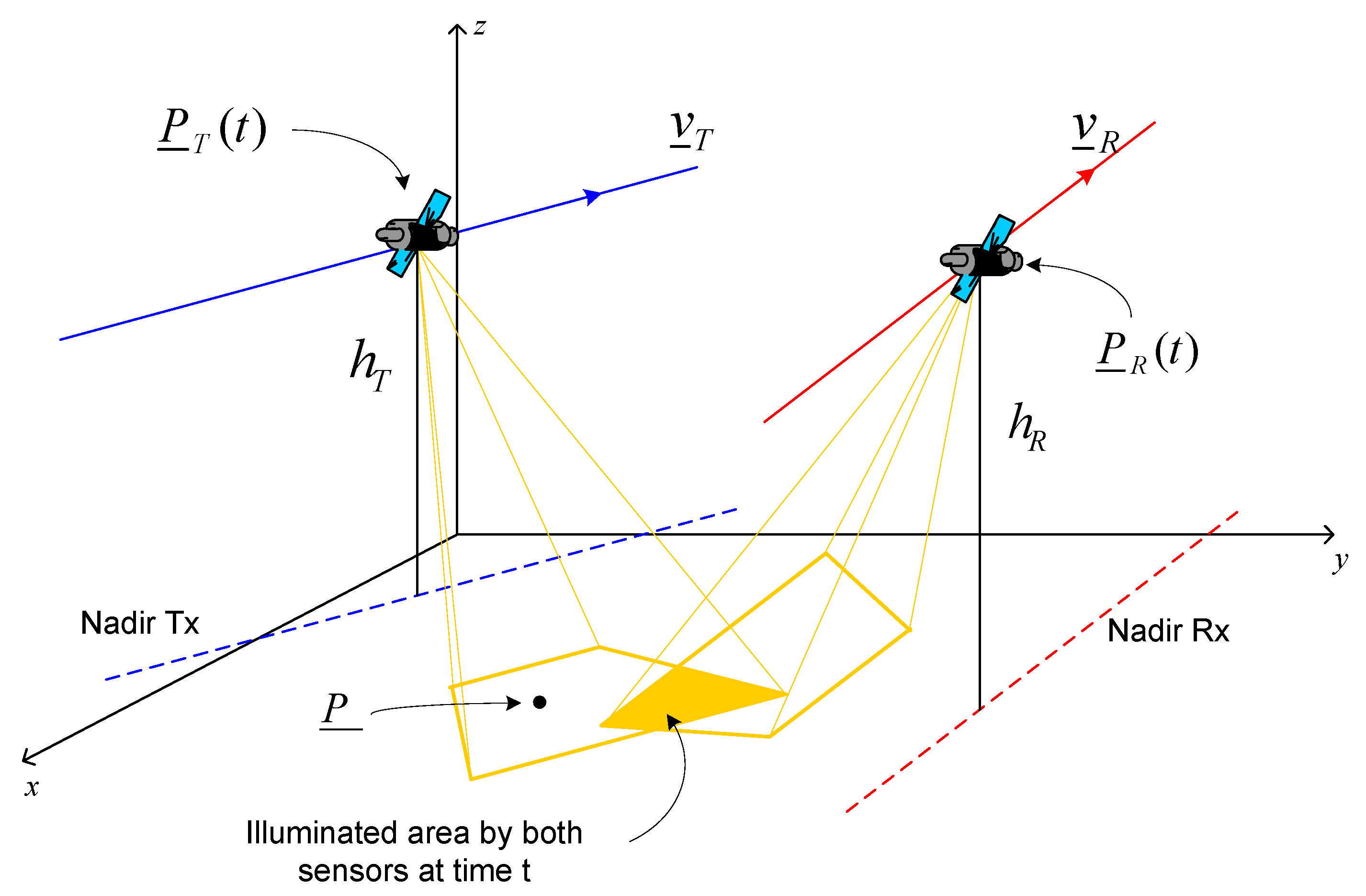
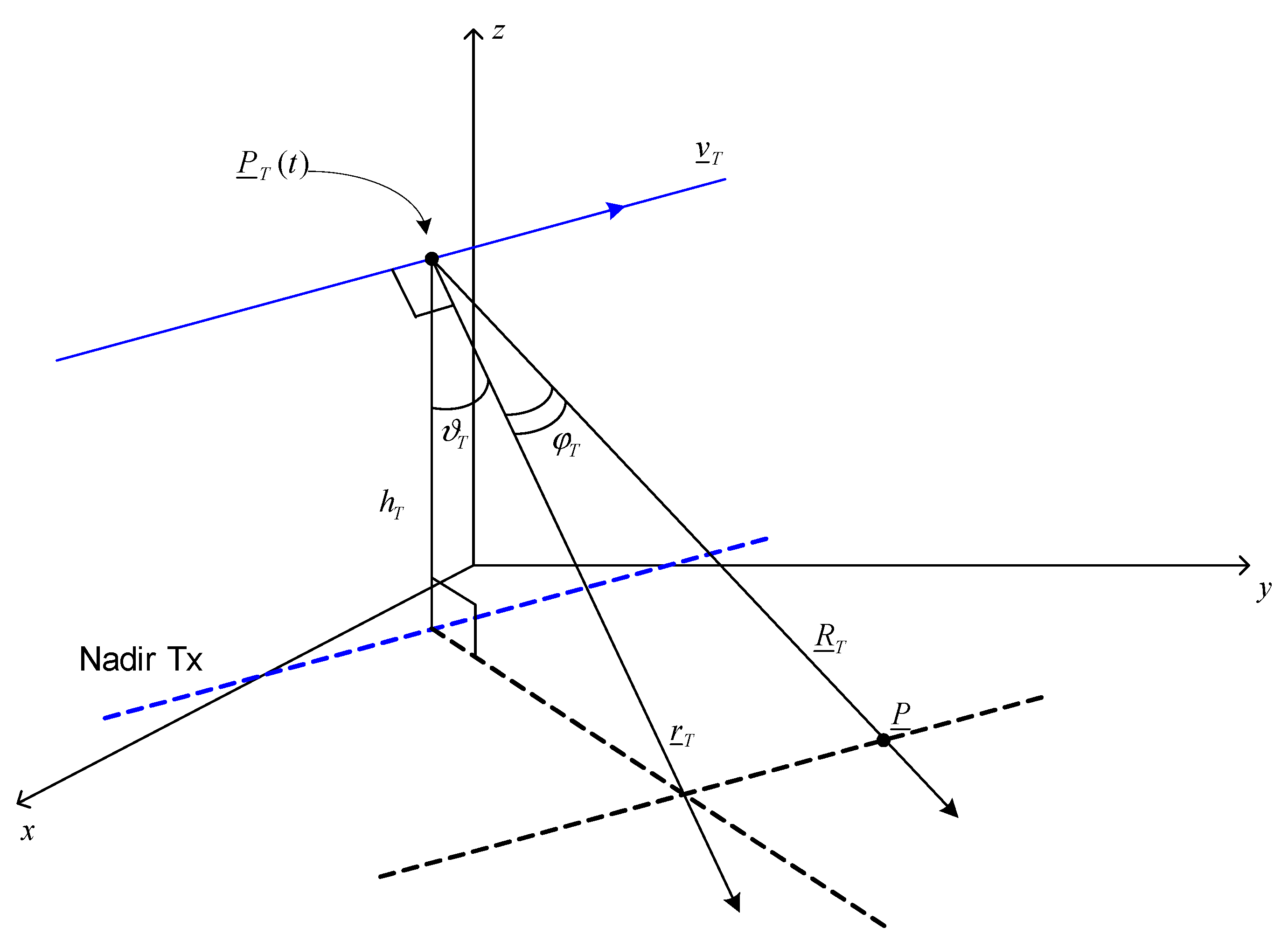
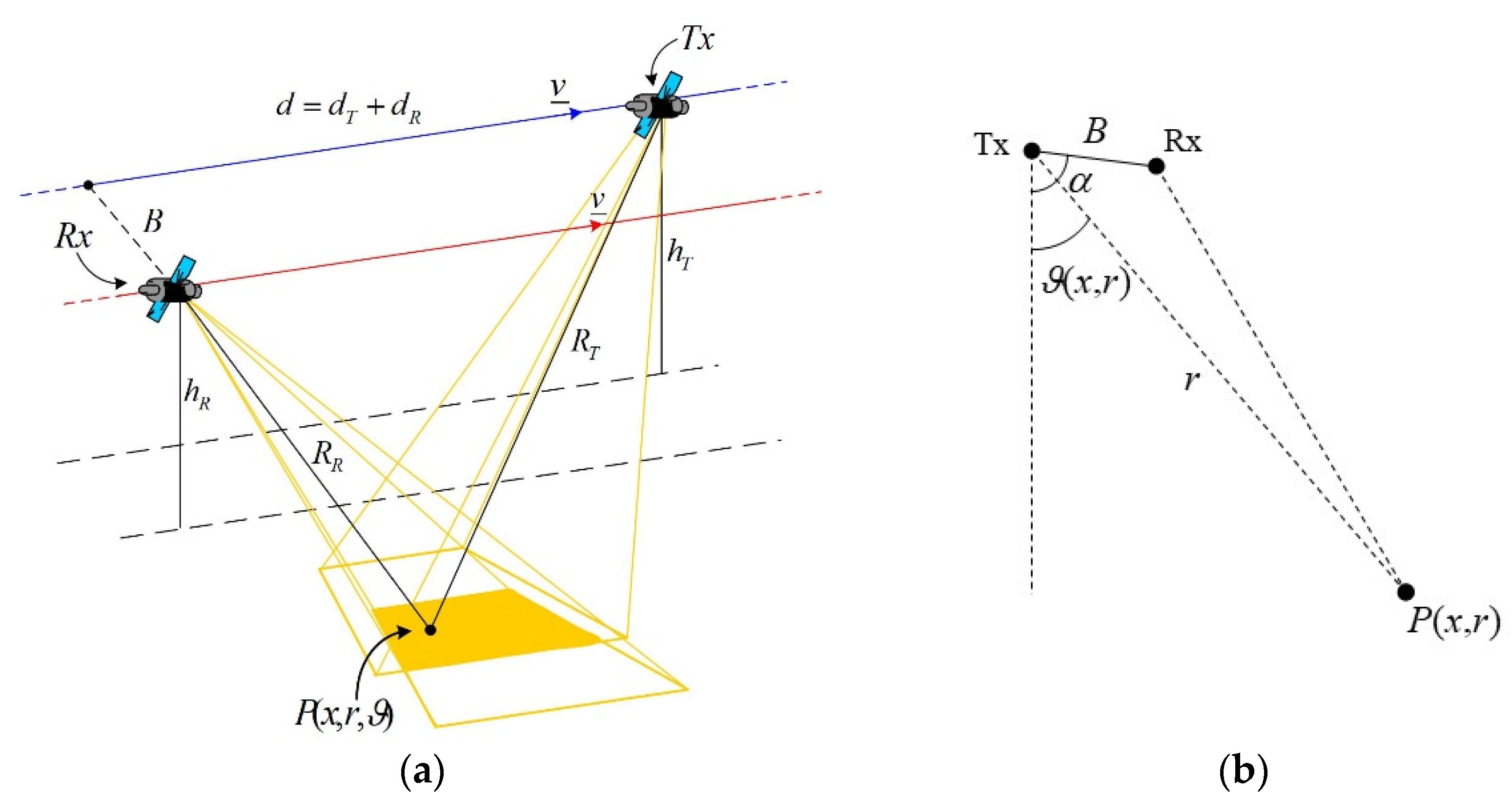


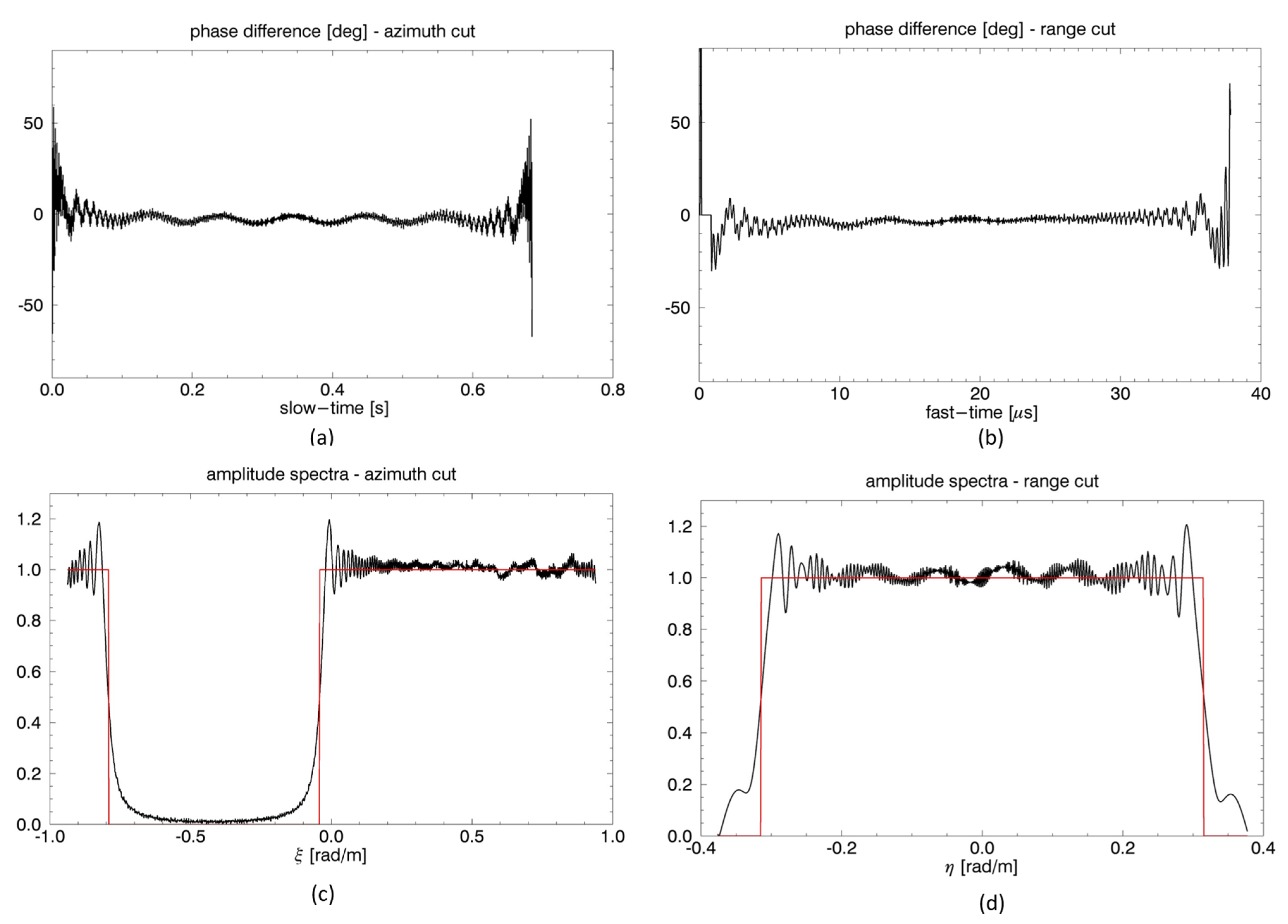
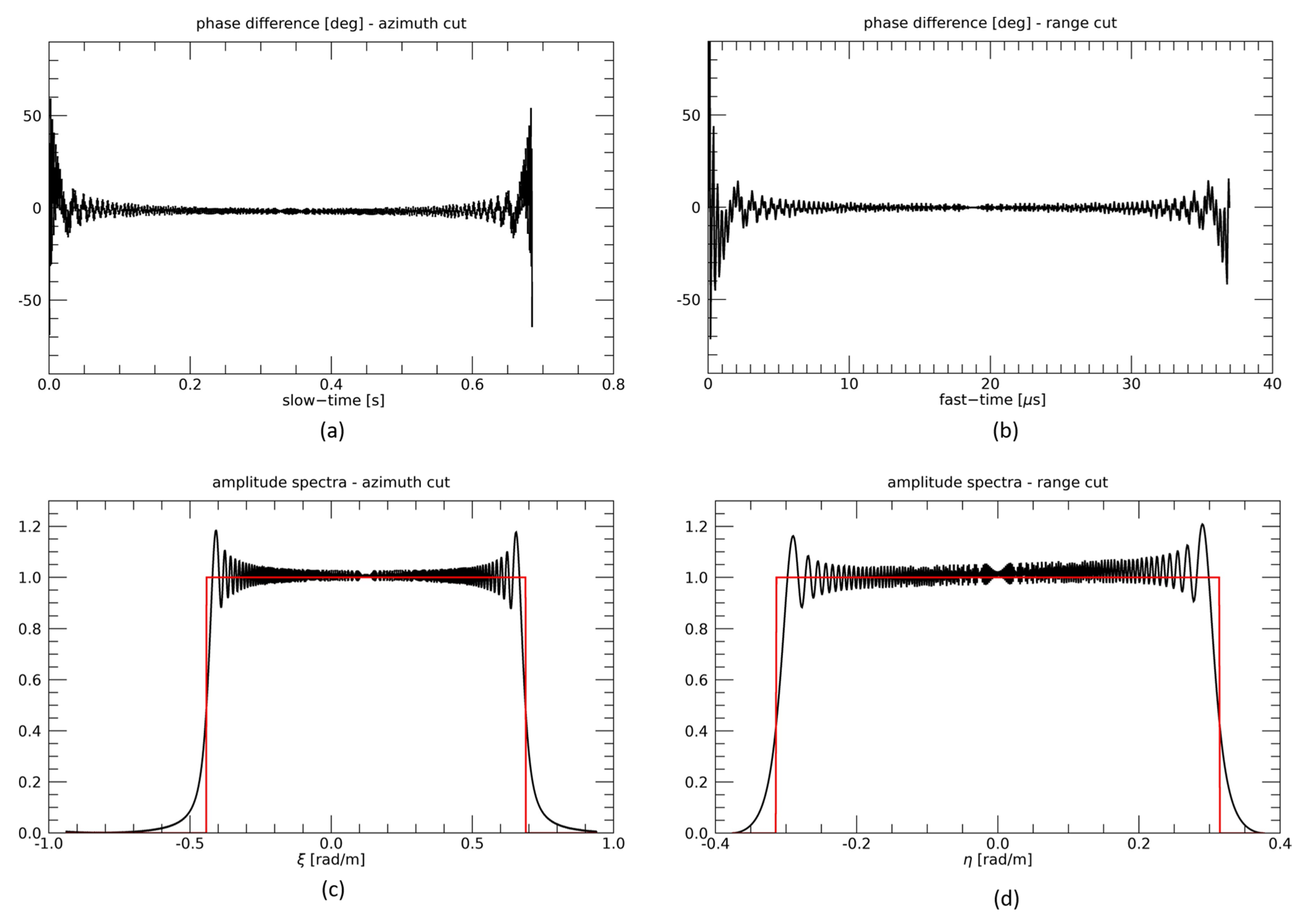

| Parameter | Measurement Unit | Value |
|---|---|---|
| Carrier frequency f | GHz | 5.1 |
| Chirp bandwidth Δf | MHz | 15 |
| Chirp duration τ | μs | 37 |
| Sampling frequency fs | MHz | 18 |
| Pulse repetition frequency PRF | kHz | 2000 |
| Transmitting and receiving antennas sizes (cross-track × along-track) | m × m | 1 × 11.1 |
| Polarization | VV | |
| Transmitter and receiver velocity v | m/s | 6691 |
| Transmitter platform height hT | km | 775 |
| Transmitter look angle ϑ0T | deg | 30 |
| Cross-track baseline B | m | First example: 8000 Second example: 20 Third example: 12,000 |
| Cross-track baseline angle α | deg | 120 |
| Along-track transmitter baseline dT | m | First example: 500 Second example: 0 Third example: 6000 |
| Along-track receiver baseline dR | m | First example: 300 Second example: 50,000 Third example: 7000 |
| Target position (x, y, z) | m | (0, 433,000, 0) |
| Parameter | Measurement Unit | Value |
|---|---|---|
| Carrier frequency f | GHz | 5.3 |
| Chirp bandwidth Δf | MHz | 15 |
| Chirp duration τ | μs | 37 |
| Sampling frequency fs | MHz | 18 |
| Pulse repetition frequency PRF | kHz | 1679 |
| Transmitting antenna size (cross-track × along-track) | m × m | 1 × 11.1 |
| Receiving antenna size (cross-track × along-track) | m × m | 0.1 × 0.1 |
| Polarization | VV | |
| Transmitter velocity v | m/s | 6691 |
| Transmitter platform height hT | km | 775 |
| Receiver platform height hR | km | 1.5 |
| Receiver look angle ϑ0R | deg | 20 |
| Cross-track ground-projected baseline Bsinα | km | 337 |
| Target position (x, y, z) | m | (0, 546, 0) |
Publisher’s Note: MDPI stays neutral with regard to jurisdictional claims in published maps and institutional affiliations. |
© 2021 by the authors. Licensee MDPI, Basel, Switzerland. This article is an open access article distributed under the terms and conditions of the Creative Commons Attribution (CC BY) license (https://creativecommons.org/licenses/by/4.0/).
Share and Cite
Di Martino, G.; Iodice, A.; Natale, A.; Riccio, D. Time-Domain and Monostatic-like Frequency-Domain Methods for Bistatic SAR Simulation. Sensors 2021, 21, 5012. https://doi.org/10.3390/s21155012
Di Martino G, Iodice A, Natale A, Riccio D. Time-Domain and Monostatic-like Frequency-Domain Methods for Bistatic SAR Simulation. Sensors. 2021; 21(15):5012. https://doi.org/10.3390/s21155012
Chicago/Turabian StyleDi Martino, Gerardo, Antonio Iodice, Antonio Natale, and Daniele Riccio. 2021. "Time-Domain and Monostatic-like Frequency-Domain Methods for Bistatic SAR Simulation" Sensors 21, no. 15: 5012. https://doi.org/10.3390/s21155012








